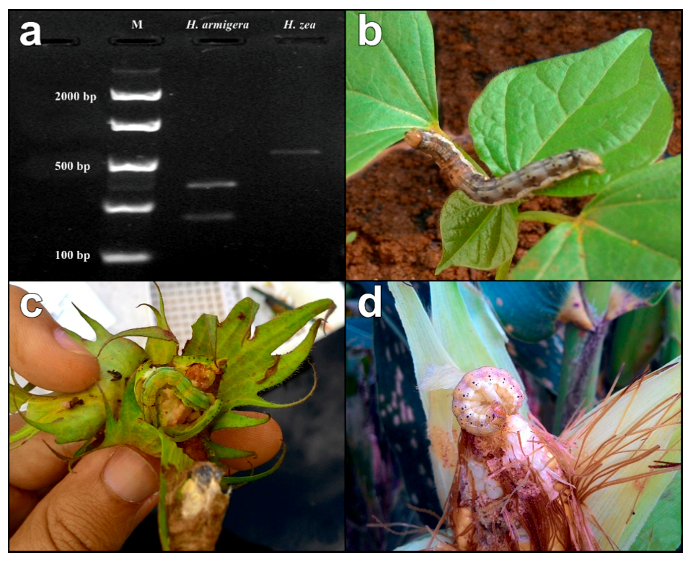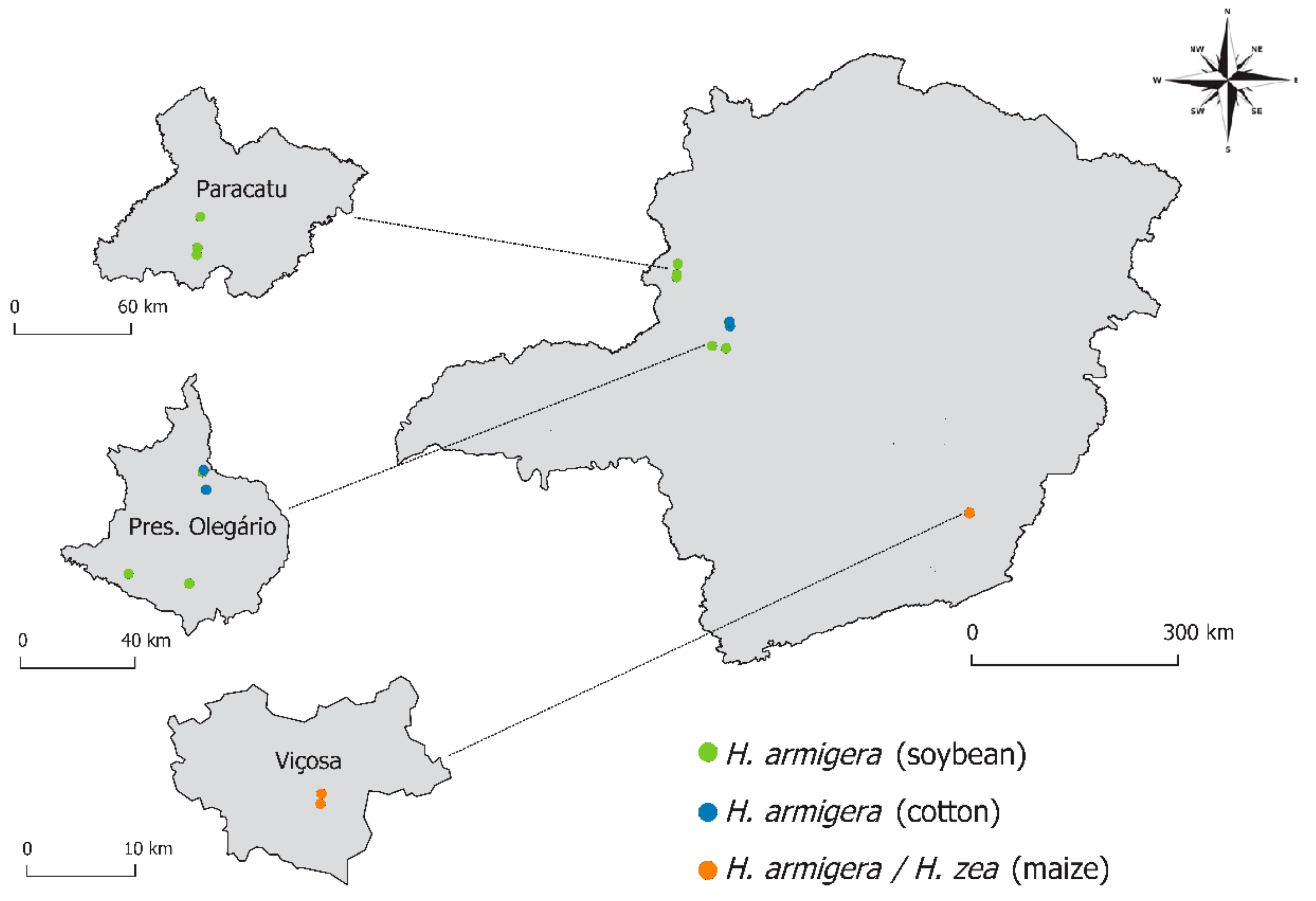The Spread of Helicoverpa armigera (Lepidoptera: Noctuidae) and Coexistence with Helicoverpa zea in Southeastern Brazil
Abstract
1. Introduction
2. Material and Methods
3. Results and Discussion
4. Conclusions
Acknowledgments
Author Contributions
Conflicts of Interest
References
- Czepak, C.; Albernaz, K.C.; Vivan, L.M.; Guimarães, H.O.; Carvalhais, T. First reported occurrence of Helicoverpa armigera (Hubner) (Lepidoptera: Noctuidae) in Brazil. Pesqui. Agropecu. Trop. 2013, 43, 110–113. [Google Scholar] [CrossRef]
- Specht, A.; Sosa-Gomez, D.R.; Paula-Moraes, S.V.; Yano, S.A.C. Morphological and molecular identification of Helicoverpa armigera (Lepidoptera: Noctuidae) and expansion of its occurrence record in Brazil. Pesqui. Agropecu. Bras. 2013, 48, 689–692. [Google Scholar] [CrossRef]
- Bueno, R.C.O.F.; Sosa-Gómez, D.R. The old world bollworm in the Neotropical region: The experience of Brazilian growers with Helicoverpa armigera. Outlooks Pest Manag. 2014, 25, 261–264. [Google Scholar] [CrossRef]
- Brasil. Portaria n.º 1168, de 26 de Novembro de 2013. Declara Estado de Emergência Fitossanitária ao Intensivo Ataque da Praga Helicoverpa Armigera nas áreas Produtoras de Góias e Municípios de Minas Gerais pelo prazo de 01 (um) ano. Available online: http://www.apps.agr.br/site/Conteudo/1253 (accessed on 20 January 2014).
- Behere, G.T.; Tay, W.T.; Russell, D.A.; Batterham, P. Molecular markers to discriminate among four pest species of Helicoverpa (Lepidoptera: Noctuidae). Bull. Entomol. Res. 2008, 98, 599–603. [Google Scholar] [CrossRef] [PubMed]
- Pratissoli, D.; Lima, V.L.; Pirovani, V.D.; Lima, W.L. Ocorrência de Helicoverpa armigera (Lepidoptera: Noctuidae) em tomateiro no estado do Espírito Santo. Hortic. Bras. 2015, 33, 101–105. (In Portuguese) [Google Scholar] [CrossRef]
- Widmer, M.; Schofield, P. Heliothis Dispersal and Migration; Tropical Development and Research Institute: London, UK, 1983; p. 41. [Google Scholar]
- Fitt, G.P. The ecology of Heliothis species in relation to agroecosystems. Ann. Rev. Entomol. 1989, 34, 17–53. [Google Scholar] [CrossRef]
- Murúa, M.G.; Scalora, F.S.; Navarro, F.R.; Cazado, L.E.; Casmuz, A.; Villagrán, M.E.; Lobos, E.; Gastaminza, G. First record of Helicoverpa armigera (Lepidoptera: Noctuidae) in Argentina. Fla. Entomol. 2014, 97, 854–856. [Google Scholar] [CrossRef]
- Formentini, A.C.; Sosa-Gómez, D.R.; Paula-Moraes, S.V.; Barros, N.M.; Specht, A. Lepidoptera (Insecta) associated with soybean in Argentina, Brazil, Chile and Uruguay. Cienc. Rural 2015, 45, 2113–2120. [Google Scholar] [CrossRef]
- Behere, G.T.; Tay, W.T.; Russell, D.A.; Heckel, D.G.; Appleton, B.R.; Kranthi, K.R.; Batterham, P. Mitochondrial DNA analysis of field populations of Helicoverpa armigera (Lepidoptera: Noctuidae) and of its relationship to H. zea. BMC Evol. Biol. 2007. [Google Scholar] [CrossRef] [PubMed]
- Berg, B.G.; Zhao, X.C.; Wang, G. Processing of pheromone information in related species of Heliothine moths. Insects 2014, 5, 742–761. [Google Scholar] [CrossRef] [PubMed]
- Laster, M.L.; Sheng, C.F. Search for hybrid sterility for Helicoverpa zea in crosses between the North American H. zea and H. armigera (Lepidoptera: Noctuidae) from China. J. Econ. Entomol. 1995, 88, 1288–1291. [Google Scholar] [CrossRef]
- Tay, W.T.; Soria, M.F.; Walsh, T.; Thomazoni, D.; Silvie, P.; Behere, G.T.; Anderson, C.; Downes, S. A brave new world for an Old World pest: Helicoverpa armigera (Lepidoptera: Noctuidae) in Brazil. PLoS ONE 2013. [Google Scholar] [CrossRef] [PubMed]
- Santos, F. Ocorrência, Dinâmica e Diversidade Genética Populacional da Helicoverpa armigera (Hübner, 1809) (Lepidoptera: Noctuidae) no estado de Santa Catarina. Master’s Thesis, Universidade Federal de Santa Catarina, Santa Catarina, Brazil, 2015. (In Portuguese). [Google Scholar]
- Alvi, A.H.; Sayyed, A.H.; Naeem, M.; Ali, M. Field evolved resistance in Helicoverpa armigera (Lepidoptera: Noctuidae) to Bacillus thuringiensis toxin Cry1Ac in Pakistan. PLoS ONE 2012. [Google Scholar] [CrossRef] [PubMed]


© 2017 by the authors. Licensee MDPI, Basel, Switzerland. This article is an open access article distributed under the terms and conditions of the Creative Commons Attribution (CC BY) license (http://creativecommons.org/licenses/by/4.0/).
Share and Cite
Pinto, F.A.; Mattos, M.V.V.; Silva, F.W.S.; Rocha, S.L.; Elliot, S.L. The Spread of Helicoverpa armigera (Lepidoptera: Noctuidae) and Coexistence with Helicoverpa zea in Southeastern Brazil. Insects 2017, 8, 87. https://doi.org/10.3390/insects8030087
Pinto FA, Mattos MVV, Silva FWS, Rocha SL, Elliot SL. The Spread of Helicoverpa armigera (Lepidoptera: Noctuidae) and Coexistence with Helicoverpa zea in Southeastern Brazil. Insects. 2017; 8(3):87. https://doi.org/10.3390/insects8030087
Chicago/Turabian StylePinto, Fábio A., Marcos V. V. Mattos, Farley W. S. Silva, Silma L. Rocha, and Simon L. Elliot. 2017. "The Spread of Helicoverpa armigera (Lepidoptera: Noctuidae) and Coexistence with Helicoverpa zea in Southeastern Brazil" Insects 8, no. 3: 87. https://doi.org/10.3390/insects8030087
APA StylePinto, F. A., Mattos, M. V. V., Silva, F. W. S., Rocha, S. L., & Elliot, S. L. (2017). The Spread of Helicoverpa armigera (Lepidoptera: Noctuidae) and Coexistence with Helicoverpa zea in Southeastern Brazil. Insects, 8(3), 87. https://doi.org/10.3390/insects8030087





